28/11/2013
FSG Educación
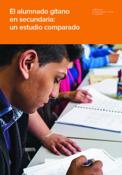
The survey highlights the wide gap between Roma and non-Roma students: the dropout rate is 51 percentage points higher.
The school failure rate among Roma students is devastatingly high. According to the survey, 64% of Roma students between the ages of 16 and 24 fail to complete their compulsory studies, compared with 13% of the overall student body; that is a difference of 51 percentage points. The dropout rate for Roma youth stands at 63.7%.
According to Isidro Rodríguez, Director of the FSG, “Education is a fundamental right which must be guaranteed and this survey highlights that this is not happening in the case of young Roma. ” It is up to government administrations to find a solution to this problem by implementing compensation measures and providing support and educational reinforcement tailored to the needs of Roma students”.
Roma can and want to study as proven by the FSG's after school support and tutoring programme called 'Promociona'. During the 2012-2013 school year, 73.5% of Roma students in their fourth (last) year of compulsory secondary school successfully graduated.
The failure rate for Roma youth is devastatingly high; 51 percentage points higher than the rate for the overall student body. The dropout rate for Roma students stands at 63.7%. These are two of the main conclusions of the report presented this morning in Madrid entitled, Roma students in secondary education: a comparative survey, compiled by the Fundación Secretariado Gitano in collaboration with UNICEF Spain, the Ministry of Health, Social Services and Equality and the Ministry of Education, Culture and Sport.
Education is a fundamental right that must be guaranteed and this survey highlights that this is not happening in the case of young Roma. At the presentation of the survey Isidro Rodríguez, director de la FSG, said that “It is up to the government administrations to find a solution to this problem by implementing compensation measures and providing support and educational reinforcement tailored to the needs of Roma students”.
Mónica Chamorro, director of the FSG's education department, remarked that “A survey that compares the educational situation of Roma students with that of the overall student body can serve as a benchmark for regional, national and European institutions as they assess whether the policies they are implementing are truly effective”.
This survey, compiled on the basis of 1,600 interviews, shows that despite the progress made over the last 30 years, i.e. widespread enrolment of Roma children in school and a more positive attitude on the part of the Roma community towards education and school, all resulting in higher levels of education, there is still a long way to go before equality can be guaranteed.
For instance, by the age of 18 significant differences were detected in enrolment rates between Roma students and the rest: at that age, 71.1% of the overall population is in school compared to only 20.8% of Roma youth.
Another figure which sheds light on the educational gap is the percentage of so-called “ni-nis”: 43.3% of Roma youngsters between the ages of 15 and 19 “neither study nor work” while that figure stands at 12.8% for the same segment of the population at large.
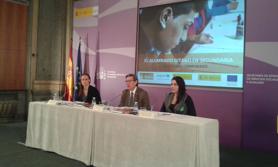
Presentation of the Report Roma students in secondary education: a comparative survey
| FAILURE AT ASCHOOL 64% of Roma students (age 16 to 24) fail to complete their compulsory studies, compared with 13% of theoverall student body. That is a difference of 51 percentage points vis-à-vis the overall student body. |
| EARLY SCHOOL LEAVING The school dropout rate among Roma youth is 63,7% (young Roma between the ages of 18 and 24 who have left school or training programmes before completing their compulsory secondary education). By age 12, a large percentage of Roma students have had to repeat at least one academic year and then typically drop out school at the age of 16. |
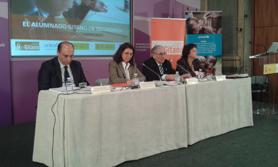
Presentation table of the data survey.
According to Mayte Suárez, director of the FSG in Extremadura “Despite the figures that have emerged in the report, those of us working at the FSG know that Roma students can and want to study and the results of our after-school support and tutoring programme called 'Promociona' bear witness to that fact.
Ms. Suárez added that “Promociona not only engages Roma students but also the others involved in the educational process: families, schools and other educational and social stakeholders. The aim is to raise academic achievement during the last two years of primary school and throughout compulsory secondary school and to encourage students to continue on with post-compulsory studies, and the data show that we are on the right path”.
Academic success among Roma students is possible. “There is no doubt that there is still much to be done but we at the FSG have the perspective to see the great strides made by the Roma community over the last several decades and this encourages us to continue working for the inclusion of Roma. Now we speak in terms of equality in secondary education rather than literacy or primary education. To conclude on a positive note, the report also indicates that 95% of the Roma population believes that education is a very important vehicle leading to success and that 60% of Roma young people between the ages of 16 and 24 go back to school with a view to finding a better job.”
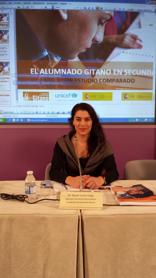
Mayte Suárez (Regional Director FSG Extremadura)
| THANKS TO ‘PROMOCIONA’, THE AFTER-SCHOOL SUPPORT AND TUTORING PROGRAMME: In the 2012-2013 school year, 73,5% of Roma students in their last year of secondary school successfully graduaded and 96% of them went on to post-compulsory studies. |
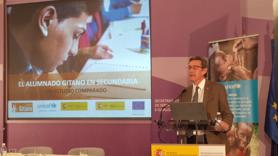
Related documents